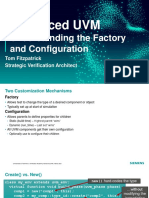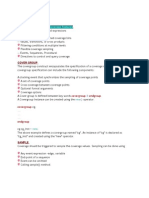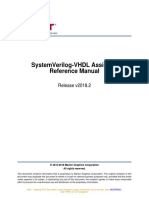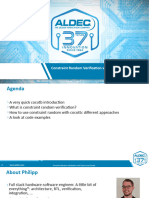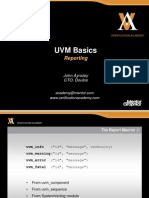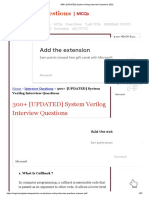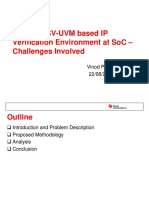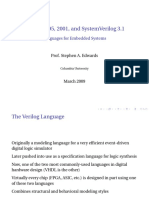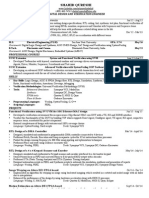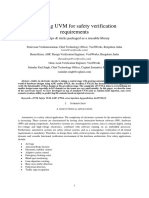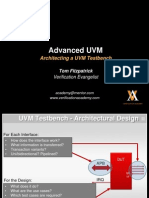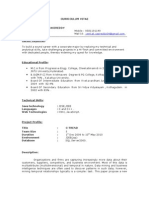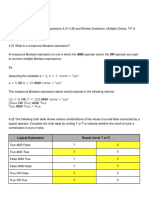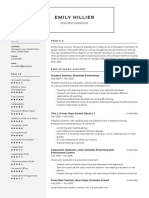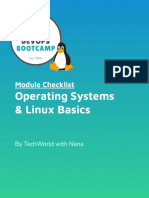12/13/12
Getting Started with UVM
Vanessa Cooper
Verification Consultant
Getting Started with UVM
What is UVM?
Building a Testbench
Creating Tests
Testbench Architecture
Phases
Sequence Items
Macros and the Factory
Configuration Database
Connecting a Scoreboard
Test Structure
Sequences
Objections
Execution
Register Model
Hooking to Legacy Code
�12/13/12
Getting Started with UVM
What is UVM?
Building a Testbench
Creating Tests
Testbench Architecture
Phases
Sequence Items
Macros and the Factory
Configuration Database
Connecting a Scoreboard
Test Structure
Sequences
Objections
Execution
Register Model
Hooking to Legacy Code
What is UVM?
NOT a new language
Library of base classes
Based off previous methodologies
Accellera standard
�12/13/12
Getting Started with UVM
What is UVM?
Building a Testbench
Creating Tests
Testbench Architecture
Phases
Sequence Items
Macros and the Factory
Configuration Database
Connecting a Scoreboard
Test Structure
Sequences
Objections
Execution
Register Model
Hooking to Legacy Code
Testbench Architecture
TEST
Testbench: Environment
Verification
Component:
Agent
DUT
Verification
Component:
Agent
�12/13/12
Testbench Architecture
Sequencer
Driver
Sequencer
AHB Bus
Agent
Monitor
Driver
DUT
Pipe Input
Agent
ACTIVE
Monitor
Monitor
ACTIVE
Pipe Output
Agent
PASSIVE
Getting Started with UVM
What is UVM?
Building a Testbench
Creating Tests
Testbench Architecture
Phases
Sequence Items
Macros and the Factory
Configuration Database
Connecting a Scoreboard
Test Structure
Sequences
Objections
Execution
Register Model
Hooking to Legacy Code
�12/13/12
Phases
build_phase
Builds components top-down
connect_phase
Connects the components in the environment
end_of_elaboration_phase
Post elaboration activity
start_of_simulation_phase
Configuration of components before the simulation begins
run_phase
Test Execution
extract_phase
Collects test details after run execution
check_phase
Checks simulation results
report_phase
Reporting of simulation results
Phases
virtual function void build_phase(uvm_phase phase);!
super.build_phase(phase);!
if(is_active == UVM_ACTIVE) begin!
sequencer = pipe_sequencer::type_id::create("sequencer", this);!
driver = pipe_driver::type_id::create("driver", this);!
end!
monitor = pipe_monitor::type_id::create("monitor", this);!
`uvm_info(get_full_name( ), "Build phase complete", UVM_LOW)!
endfunction: build_phase
Call super.build_phase first
Configure before creating
Create the component
�12/13/12
Phases
virtual function void connect_phase(uvm_phase phase);!
ahb_env.agent.monitor.ic_port.connect(sboard.pkts_coll.analysis_export);!
ahb_env.agent.monitor.ic_port.connect(coverage.analysis_export);!
`uvm_info(get_full_name( ), "Connect phase complete", UVM_LOW)!
endfunction: connect_phase
Sequencer
Driver
Scoreboard
AHB Bus
Agent
Monitor
Phases
Sequences
Sequencer
Agent
Driver
DUT
Monitor
virtual task run_phase(uvm_phase phase);!
fork!
...!
get_and_drive( );!
...!
join!
endtask: run_phase
�12/13/12
Phases
virtual task get_and_drive( );!
forever begin!
@(posedge vif.rst_n);!
while(vif.rst_n != 1'b0) begin!
seq_item_port.get_next_item(req);!
drive_packet(req);!
seq_item_port.item_done( );!
end!
end!
endtask: get_and_drive
Sequencer
seq_item_export!
seq_item_port!
virtual task drive_packet(data_packet pkt);!
@(posedge vif.clk);!
vif.data = pkt.data;!
endtask: drive_packet
Driver
Getting Started with UVM
What is UVM?
Building a Testbench
Creating Tests
Testbench Architecture
Phases
Sequence Items
Macros and the Factory
Configuration Database
Connecting a Scoreboard
Test Structure
Sequences
Objections
Execution
Register Model
Hooking to Legacy Code
�12/13/12
Sequence Items
class data_packet extends uvm_sequence_item;!
rand bit [15:0] data;!
!
`uvm_object_utils_begin(data_packet)!
`uvm_field_int(data, UVM_DEFAULT)!
`uvm_object_utils_end!
!
function new(string name = "data_packet");!
super.new(name);!
endfunction!
endclass: data_packet
Getting Started with UVM
What is UVM?
Building a Testbench
Creating Tests
Testbench Architecture
Phases
Sequence Items
Macros and the Factory
Configuration Database
Connecting a Scoreboard
Test Structure
Sequences
Objections
Execution
Register Model
Hooking to Legacy Code
�12/13/12
Macros and the Factory
Macros
Utility macros registers the class with the factory
and gives access to the create method:
`uvm_object_utils and `uvm_component_utils
Field automation macros give access to common
functions such as copy( ) and clone( ) :
`uvm_field_int
Factory
Substitute components
Defer to run-time for object allocation
Macros and the Factory
!
`uvm_object_utils_begin(data_packet)!
`uvm_field_int(data, UVM_DEFAULT)!
`uvm_object_utils_end!
Macros
class monitor extends uvm_monitor;!
data_packet pkt;!
...!
pkt = new("pkt");!
pkt = data_packet::type_id::create("pkt", this);!
...!
endclass
Factory
�12/13/12
Macros and the Factory
All
object::type_id::set_type_override(derived_obj::get_type( ));!
!
data_packet::type_id::set_type_override(short_pkt::get_type( ));
Inst
object::type_id::set_inst_override(derived_obj::get_type( ),
path");!
!
data_packet::type_id::set_inst_override(short_pkt::get_type( ),
"env.agent.*");
Getting Started with UVM
What is UVM?
Building a Testbench
Creating Tests
Testbench Architecture
Phases
Sequence Items
Macros and the Factory
Configuration Database
Connecting a Scoreboard
Test Structure
Sequences
Objections
Execution
Register Model
Hooking to Legacy Code
10
�12/13/12
Configuration Database
uvm_config_db#(TYPE)::set(uvm_root::get( ), "*.path", "label", value);
dut_intf
vif
retry_count
rty_cnt
my_env_cfg
env_cfg
uvm_config_db#(TYPE)::get(this, "", "label", value);
retry_count
rty_cnt
Configuration Database
Top
dut_if vif(.clk(clk),.rst_n(rst_n));
initial begin
...
uvm_config_db#(virtual dut_if)::set(uvm_root::get( ), "*",
"dut_intf", vif);
...
end
static function void set(uvm_component
string
string
T
cntxt,
inst_name,
field_name,
value)
11
�12/13/12
Configuration Database
uvm_config_db#(virtual dut_if)::get(this, "", "dut_intf",
vif);
Monitor
static function bit get(
uvm_component
string
string
ref T
cntxt,
inst_name,
field_name,
value)
Configuration Database
uvm_config_db#(virtual dut_if)::get(this, "", "dut_intf",
vif);
Monitor
if(!uvm_config_db#(virtual dut_if)::get(this, "", "dut_intf",
vif))
`uvm_fatal("NOVIF", {"virtual interface must be set for:
", get_full_name( ), ".vif"});
12
�12/13/12
Configuration Database
class ahb_agent extends uvm_agent;!
uvm_active_passive_enum is_active = UVM_ACTIVE!
!
`uvm_component_utils_begin(ahb_agent)!
`uvm_field_enum(uvm_active_passive_enum, is_active, UVM_ALL_ON)!
`uvm_component_utils_end!
!
...!
endclass
Configure in env in test
uvm_config_db#(int)::set(this, "env.agent", "is_active", UVM_PASSIVE);
Create env in test
env = ahb_env::type_id::create("env", this);
Create agent in env
agent = ahb_agent::type_id::create("agent", this);
Configuration Database
PROBLEM
Reuse Monitor and Interface for Input and Output
Ensure Monitor selects correct Interface
Sequencer
Driver
DUT
Pipe Input
Agent
Monitor
ACTIVE
Monitor
Pipe Output
Agent
PASSIVE
13
�12/13/12
Configuration Database
Top
dut_if dut_ivif(.clk(clk), .rst_n(rst_n));
dut_if dut_ovif(.clk(clk), .rst_n(rst_n));
!
initial begin
...
uvm_config_db#(virtual dut_if)::set(uvm_root::get( ), "*",
"input_dut_intf",dut_ivif);
uvm_config_db#(virtual dut_if)::set(uvm_root::get( ), "*",
"output_dut_intf", dut_ovif);
...
end
Configuration Database
class dut_monitor extends uvm_monitor;
virtual dut_if vif;
string monitor_intf;
...
endclass: dut_monitor
Monitor
uvm_config_db#(string)::set(this,"input_env.agent.monitor",
"monitor_intf", "input_dut_intf");
ENV
uvm_config_db#(string)::set(this, "output_env.agent.monitor",
"monitor_intf", "output_dut_intf");
14
�12/13/12
Configuration Database
input_dut_intf
dut_ivif
output_dut_intf
dut_ovif
input_env.agent.monitor
monitor_intf
input_dut_intf
output_env.agent.monitor
monitor_intf
output_dut_intf
Configuration Database
class dut_monitor extends uvm_monitor;
virtual dut_if vif;
string monitor_intf;
Monitor
uvm_config_db#(string)::get(this, "", "monitor_intf",
monitor_intf);
uvm_config_db#(virtual dut_if)::get(this, "",
monitor_intf, vif);
...
endclass: dut_monitor
input_env.agent.monitor
monitor_intf
input_dut_intf
input_dut_intf
dut_ivif
15
�12/13/12
Configuration Database
uvm_config_db#(virtual dut_if)::set(uvm_root::get( ), "*",
"input_dut_intf",dut_ivif);
Top
uvm_config_db#(virtual dut_if)::set(uvm_root::get( ),
"*.dut_agent.monitor", "input_dut_intf",dut_ivif);
Getting Started with UVM
What is UVM?
Building a Testbench
Creating Tests
Testbench Architecture
Phases
Interfaces and Sequence Items
Macros and the Factory
Configuration Database
Connecting a Scoreboard
Test Structure
Sequences
Objections
Execution
Register Model
Hooking to Legacy Code
16
�12/13/12
Connecting a Scoreboard
PROBLEM
What is a simple way to connect the monitors to the
scoreboard?
Scoreboard
Sequencer
Monitor
DUT
Pipe Agent
Monitor
Driver
Pipe Agent
Connecting a Scoreboard
class dut_monitor extends uvm_monitor;
...
uvm_analysis_port #(data_packet) items_collected_port;
data_packet data_collected;
data_packet data_clone;
...
endclass: dut_monitor
Monitor
Scoreboard
CLONE
DATA
17
�12/13/12
Connecting a Scoreboard
class dut_monitor extends uvm_monitor;
...
virtual task collect_packets;
...
$cast(data_clone, data_collected.clone( ));
items_collected_port.write(data_clone);
endtask: collect_packets
...
endclass: dut_monitor
Monitor
CLONE
Scoreboard
FIFO
DATA
Connecting a Scoreboard
class dut_scoreboard extends uvm_scoreboard;
...
uvm_tlm_analysis_fifo #(data_packet) input_packets_collected;
uvm_tlm_analysis_fifo #(data_packet) output_packets_collected;
...
virtual task watcher( );
forever begin
@(posedge top.clk);
if(input_packets_collected.used( ) != 0) begin
...
end
end
endtask: watcher
endclass: dut_scoreboard
18
�12/13/12
Connecting a Scoreboard
virtual task watcher( );
forever begin
@(posedge top.clk);
if(input_packets_collected.used( ) != 0) begin
...
end
end
endtask: watcher
virtual task watcher( );
forever begin
input_packets_collected.get(input_packets);
...
end
end
endtask: watcher
Connecting a Scoreboard
input_env.agent.monitor.items_collected_port.connect
(scoreboard.input_packets_collected.analysis_export);
ENV
output_env.agent.monitor.items_collected_port.connect
(scoreboard.output_packets_collected.analysis_export);
Monitor
CLONE
Scoreboard
FIFO
DATA
19
�12/13/12
Getting Started with UVM
What is UVM?
Building a Testbench
Creating Tests
Testbench Architecture
Phases
Interfaces and Sequence Items
Macros and the Factory
Configuration Database
Connecting a Scoreboard
Test Structure
Sequences
Objections
Execution
Register Model
Hooking to Legacy Code
Getting Started with UVM
What is UVM?
Building a Testbench
Creating Tests
Testbench Architecture
Phases
Interfaces and Sequence Items
Macros and the Factory
Configuration Database
Connecting a Scoreboard
Test Structure
Sequences
Objections
Execution
Register Model
Hooking to Legacy Code
20
�12/13/12
Test Structure
TEST
Testbench: Environment
Verification
Component:
Agent
DUT
Verification
Component:
Agent
Test Structure
class base_test extends uvm_test;!
`uvm_component_utils(base_test)!
!
dut_env
env;!
dut_env_cfg
env_cfg;!
!
function new(string name, uvm_component parent);!
super.new(name, parent);!
endfunction!
!
function void build_phase(uvm_phase phase);!
super.build_phase(phase);!
env_cfg = dut_env_cfg::type_id::create("env_cfg");!
!
uvm_config_db#(dut_env_cfg)::set(this, "*", "dut_env_cfg",!
env_cfg);!
!
env = dut_env::type_id::create("env", this);!
endfunction!
!
endclass: base_test!
21
�12/13/12
Test Structure
class test extends base_test;!
`uvm_component_utils(test)!
random_sequence seq;!
!
function new(string name, uvm_component parent);!
super.new(name, parent);!
endfunction!
!
function void build_phase(uvm_phase phase);!
super.build_phase(phase);!
endfunction!
!
virtual task run_phase(uvm_phase phase);!
phase.raise_objection(this);!
seq = random_sequence::type_id::create("seq");!
seq.start(env.agent.sequencer);!
phase.drop_objection(this);!
endtask!
endclass: test!
Getting Started with UVM
What is UVM?
Building a Testbench
Creating Tests
Testbench Architecture
Phases
Interfaces and Sequence Items
Macros and the Factory
Configuration Database
Test Structure
Sequences
Objections
Execution
Register Model
Hooking to Legacy Code
22
�12/13/12
Sequences
seq
Sequencer
Driver
DUT
Agent
Monitor
Sequences
class random_sequence extends uvm_sequence #(data_packet);!
`uvm_object_utils(random_sequence)!
!
function new(string name = "random_sequence");!
super.new(name);!
endfunction!
!
virtual task body( );!
`uvm_do(req);!
endtask!
!
endclass: random_sequence
req is a member of uvm_sequence that is parameterized as data_packet
`uvm_do creates the transaction, randomizes it, and sends it to the sequencer
23
�12/13/12
Sequences
class constrained_seq extends uvm_sequence #(data_packet);!
`uvm_object_utils(constrained_seq)!
!
function new(string name = "constrained_seq");!
super.new(name);!
endfunction!
!
virtual task body( );!
`uvm_do_with(req, {req.data < 16'ha;})!
endtask!
!
endclass: constrained_seq!
`uvm_do_with further constrains sequence_item members
Getting Started with UVM
What is UVM?
Building a Testbench
Creating Tests
Testbench Architecture
Phases
Interfaces and Sequence Items
Macros and the Factory
Configuration Database
Connecting a Scoreboard
Test Structure
Sequences
Objections
Execution
Register Model
Hooking to Legacy Code
24
�12/13/12
Objections
Used to communicate when it is safe to end
Components or Sequences can raise or drop objections
Objections must be raised at start of a phase
Phase persists until all objections are dropped
Objections
virtual task run_phase(uvm_phase phase);!
phase.raise_objection(this);!
seq = random_sequence::type_id::create("seq");!
seq.start(env.agent.sequencer);!
phase.drop_objection(this);!
endtask
25
�12/13/12
Getting Started with UVM
What is UVM?
Building a Testbench
Creating Tests
Testbench Architecture
Phases
Interfaces and Sequence Items
Macros and the Factory
Configuration Database
Connecting a Scoreboard
Test Structure
Sequences
Objections
Execution
Register Model
Hooking to Legacy Code
Execution
module top;!
...!
dut_if intf(.clk(clk), .rst_n(rst_n));!
!
initial begin!
uvm_config_db#(virtual dut_if)::set(uvm_root::get( ), "*",!
"dut_intf", intf);!
!
run_test( );!
end!
endmodule: top
+UVM_TESTNAME=test1
26
�12/13/12
Getting Started with UVM
What is UVM?
Building a Testbench
Creating Tests
Testbench Architecture
Phases
Interfaces and Sequence Items
Macros and the Factory
Configuration Database
Connecting a Scoreboard
Test Structure
Sequences
Objections
Execution
Register Model
Hooking to Legacy Code
Register Model
PROBLEM
Use the Register Model with the pipeline AHB bus
Capture read data accurately
Register
Model
A
D
A
P
T
E
R
Sequencer
AHB Bus
Agent
Driver
DUT
Monitor
27
�12/13/12
Register Model
Address Phase
Data Phase
HCLK
HADDR
HWRITE
DATA
(A)
HWDATA[31:0]
Register Model
Register
Model
A
D
A
P
T
E
R
Sequencer
AHB Bus
Agent
Driver
DUT
Monitor
PREDICTOR
28
�12/13/12
Register Model
build_phase
Create the predictor with the bus
uvm_sequence_item parameter in your env
connect_phase
Set the predictor map to the register model
map
Set the predictor adapter to the register
adapter
Connect the predictor to the monitor
Register Model
ENV
Declare
uvm_reg_predictor#(ahb_transfer) reg_predictor;
Create
reg_predictor = uvm_reg_predictor#(ahb_transfer)::
type_id::create("reg_predictor", this);
Map
reg_predictor.map = master_regs.default_map;
reg_predictor.adapter = reg2ahb_master;
ahb_env.agent.monitor.item_collected_port.
connect(reg_predictor.bus_in);
Connect
29
�12/13/12
Register Model
master_regs.default_map.set_auto_predict(0);
Implicit
Explicit
Passive
Getting Started with UVM
What is UVM?
Building a Testbench
Creating Tests
Testbench Architecture
Phases
Interfaces and Sequence Items
Macros and the Factory
Configuration Database
Connecting a Scoreboard
Test Structure
Sequences
Objections
Execution
Register Model
Hooking to Legacy Code
30
�12/13/12
Hooking to Legacy Code
Dont Touch the BFM
Reusable access to items in the instantiated
hierarchy and module items
Informing the SV testbench about the legacy
BFM
Hooking to Legacy Code
Legacy
BFM
SV
API
UVM
Testbench
31
�12/13/12
Hooking to Legacy Code
module SAMPLE_BFM(ports to connect to DUT signals);!
logic L;!
task T( ); ... endtask!
endmodule!
Need access to signal L and task T
+UVM_TESTNAME=test1
Hooking to Legacy Code
Define a API
Access to the UVM testbench
Access to the legacy BFM
Base class with pure virtual methods
Define in a package
Derived class will implement functions
32
�12/13/12
Hooking to Legacy Code
package SAMPLE_BFM_uvm_wrapper;!
import uvm_pkg::*;!
!
virtual class SAMPLE_BFM_access extends uvm_object;!
function new(string name);!
super.new(name);!
endfunction!
!
pure virtual function logic get_L( );!
pure virtual task run_T( );!
endclass!
endpackage!
Hooking to Legacy Code
Derive a child class and implement functions
Physical hook to Legacy BFM
Create class in interface
33
�12/13/12
Hooking to Legacy Code
interface SAMPLE_BFM_uvm_gasket;!
import SAMPLE_BFM_uvm_wrapper::*;!
!
//This class lives in the hierarchy so it can access!
//signals and task by XMR.!
class concrete_access extends SAMPLE_BFM_access;!
function new(string name);!
super.new(name);!
endfunction!
!
Upwards XMR!
function logic get_L( );!
return SAMPLE_BFM.L;!
endfunction!
!
task run_T( );!
SAMPLE_BFM.T( );!
endtask!
!
endclass!
...
Hooking to Legacy Code
Assume that the interfaces will be instantiated
within an instance of the legacy BFM.
Any XMR in this interface that begins with the
module name SAMPLE_BFM will become and
upwards XMR.
34
�12/13/12
Hooking to Legacy Code
...!
concrete_access ACCESS;!
!
//Provide a function that will return the!
//concrete_access object, constructing it on demand.!
function automatic SAMPLE_BFM_access get_access( );!
if (ACCESS == null)!
ACCESS = new($sformatf("%m.ACCESS"));!
return ACCESS;!
endfunction!
endinterface
signal and task access straightforward since embedded
class is in the scope of the interface
get_access( ) provides easy access to embedded UVM
object
Hooking to Legacy Code
Create an instance of the interface in the hierarchy!
bind SAMPLE_BFM SAMPLE_BFM_uvm_gasket uvm_gasket_instance( );
Reference probe class and pass to UVM testbench!
module top;!
import uvm_pkg::*;!
!
initial begin!
uvm_config_db#(SAMPLE_BFM_uvm_wrapper::SAMPLE_BFM_access)::!
set(uvm_root::get( ), "*",!
"access_gasket", BFM_inst.uvm_gasket_instance.get_access( ));!
!
run_test( );!
end!
endmodule: top
35
�12/13/12
Questions?
What is UVM?
Building a Testbench
Creating Tests
Testbench Architecture
Phases
Interfaces and Sequence Items
Macros and the Factory
Configuration Database
Connecting a Scoreboard
Test Structure
Sequences
Objections
Execution
Register Model
Hooking to Legacy Code
36
